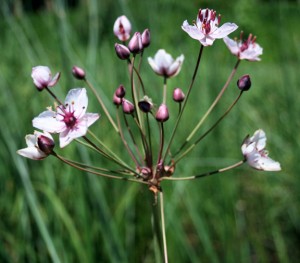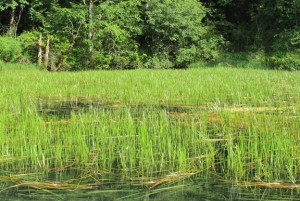by Matt Bischof and Jenifer Parsons, Department of Ecology
Flowering rush (Butomus umbellatus), an invasive aquatic plant native to northern Europe and western Asia, was first documented in North American in 1897 in Canada’s St. Lawrence River. Flowering rush has since spread to many states and provinces along the U.S.- Canada border, including Washington, often because of its sale as an ornamental pond plant. Once established, the rush can form dense beds, crowding out native aquatic and shoreline plants and interfering with recreation. It is also implicated in increasing problems with swimmer’s itch; flowering rush provides habitat to the snails that host the swimmer’s itch parasite during part of its life cycle.
Flowering rush is perennial and grows from creeping roots called rhizomes. It thrives as an emergent plant on shore in saturated sand, mud, or cobble and can survive out to depths of 15-20 feet. Emergent plants may flower in mid-summer, producing 20-50 pink flowers in a ball-like cluster at the end of a flower stalk. However, the variety thought to have reached Washington does not form many flowers, and is sterile, so does not form seeds.
Even when sterile, however, the rush can spread rapidly. The rhizomes break easily and can also form buds that break off. Both fragments and buds can float away to form new plants. Water and wave action, disturbance from boats, and grazing by geese or other animals can break up and spread the rhizomes.
Flowering rush has triangular leaves that grow from the rhizome. The leaves are erect on emergent plants in shallow water, but are typically flexible on submersed plants. The triangular shape flattens toward the leaf tip, but a distinct mid-rib can be felt even as it flattens. Sometimes emergent leaves twist toward the tip. The leaves are always fibrous, even on submersed plants.
Flowering rush is listed as a Class A noxious weed in Washington, which means that eradication is the goal. It is also included on Washington’s quarantine list; therefore, buying or possessing any part of the plant is prohibited. Currently, populations of flowering rush are known to be present in Whatcom County’s Silver Lake, some seasonal wetlands on Joint Base Lewis-McChord, the Yakima and Columbia Rivers in south central Washington, the Pend-Oreille River, and Lake Spokane (see map).
While concerned parties are trying to slow the plant’s spread in all these spots, control of flowering rush is proving elusive. Herbicide trials here, in Montana, and in Minnesota have met with marginal success. In river systems, the only practical control methods are hand pulling or covering with landscape mats, both of which are time- and cost-intensive. Consequently, populations of flowering rush in Washington continue to spread.
If you spot flowering rush in a location not listed above, please contact Jenifer Parsons immediately at (509) 457-7136 or jenp461@ecy.wa.gov













